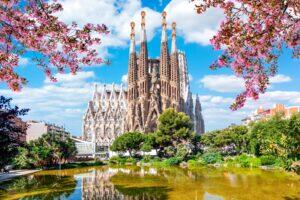Fodor's Expert Review Estadi Olímpic Lluís Companys
The Olympic Stadium was originally built for the International Exhibition of 1929, with the idea that Barcelona would then host the 1936 Olympics (ultimately staged in Hitler's Berlin). After failing twice to win the nomination, the city celebrated the attainment of its long-cherished goal by renovating the semi-derelict stadium—preserving the original facade and shell—in time for 1992, providing seating for 60,000.
Though you can view the stadium for free from the entrance area, the field and indoor areas are not normally open to the public. That said, tickets to a Barcelona Football Club ( www.fcbarcelona.com) match will get you in. The beloved team will be playing its home games here while Camp Nou undergoes a multiyear renovation (due for completion in Nov. 2024). You can also enter with a concert ticket; the stadium occasionally plays host to major acts like Coldplay and Harry Styles.
The nearby Museu Olímpic i de l'Esport, a... READ MORE
The Olympic Stadium was originally built for the International Exhibition of 1929, with the idea that Barcelona would then host the 1936 Olympics (ultimately staged in Hitler's Berlin). After failing twice to win the nomination, the city celebrated the attainment of its long-cherished goal by renovating the semi-derelict stadium—preserving the original facade and shell—in time for 1992, providing seating for 60,000.
Though you can view the stadium for free from the entrance area, the field and indoor areas are not normally open to the public. That said, tickets to a Barcelona Football Club ( www.fcbarcelona.com) match will get you in. The beloved team will be playing its home games here while Camp Nou undergoes a multiyear renovation (due for completion in Nov. 2024). You can also enter with a concert ticket; the stadium occasionally plays host to major acts like Coldplay and Harry Styles.
The nearby Museu Olímpic i de l'Esport, a museum about the Olympic movement in Barcelona, shows audiovisual replays from the 1992 Olympics, and provides interactive simulations for visitors to experience the training and competition of Olympic athletes. An information center traces the history of the modern Olympics from Athens in 1896 to the present. Next door and just downhill stands the futuristic Palau Sant Jordi sports and concert arena, designed by the noted Japanese architect Arata Isozaki.
READ LESS








